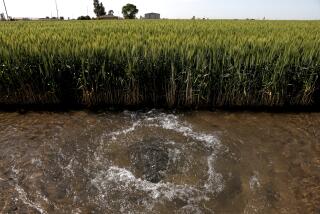6 Bills Would Move More Water South
SACRAMENTO — The chairman of the Senate Water Committee on Wednesday announced legislation to move more northern water to Southern California and to implement by January a construction schedule for facilities needed to do the job.
Chairman Ruben Ayala (D-Chino), who for years met with frustration in trying to win approval for a Peripheral Canal around the Sacramento-San Joaquin Delta to provide more water for the south, unveiled a package of six bills designed to shatter what he called the “status quo” in water development.
The program represents what he described as an effort to “get moving” to meet the demand for water of growing Southern California by the year 2000. And, unofficially, it constitutes Ayala’s first shot in what some environmentalists and water developers see as the north versus south water war of 1987.
The picturesque delta, the hub for collection of Northern California water, is a vast series of islands treasured by boaters, environmentalists and others. Fresh water from the Sacramento and San Joaquin rivers repels salinity from San Francisco Bay and helps flush out the bay. Protecting water quality in the delta has been the key issue in virtually every recent fight over providing additional water to the south.
Rather than specifying a Peripheral Canal or any other particular means of transferring water, Ayala is proposing that Gov. George Deukmejian’s Administration be required to designate no later than next Jan. 5 a delta conveyance “facility” and establish a schedule for its construction. The Peripheral Canal idea has been back-burnered ever since legislation to authorize it was rejected in a statewide 1980 referendum vote.
Administration’s Attitude
Following defeat by the Legislature of his water development plan in 1984, Deukmejian said it would be up to feuding north-south lawmakers to take the lead in fashioning a future compromise and send it to him. As a result, Administration officials have advanced no new ambitious programs and instead have concentrated on a low-profile incremental approach to water development.
But Ayala told a press conference, “I am convinced unless the Administration picks (a) transfer facility, it will never get built.”
Ayala’s legislation also envisions widening, deepening and straightening unspecified rivers and sloughs in the delta to provide additional capacity for water to flow to California Water Project pumps near Tracy, which feed the aqueduct that serves the San Joaquin Valley and Southern California. The Administration currently is investigating such “channel modifications.” Ayala said it is up to the Department of Water Resources to select the rivers and sloughs for modification because it has “the know-how and the technology.”
Doubts Expressed
Water Resources Director David Kennedy said he had not yet examined the Ayala proposal and declined to comment on it. Likewise, representatives of environmental protection organizations, while saying they had not read the bills, expressed doubts about Ayala’s plan.
Thomas Graff of the Environmental Defense Fund said, “There are probably a few good ideas mixed in with an awful lot of mischievous proposals.” He said he preferred the Deukmejian Administration’s “deliberative” method rather than Ayala’s “confrontational” method.
The Ayala legislation would direct the governor to start construction by 1990 on the already authorized Los Banos Grandes Reservoir, a Merced County facility that would store approximately 2 million acre-feet of Northern California floodwater for use by the southern San Joaquin Valley and Southern California during a drought. “And a drought will come,” Ayala warned.
For Contra Costa County, a powerful voice in delta water issues, the legislation would authorize construction of two 100,000 acre-foot reservoirs to provide a backup supply in the event of a water shortage.
Pumping Increase
To capture the floodwater for storage and any other additional water, the pumping operation at Tracy would have to be increased from the current 71% level to full capacity, Ayala said. His legislation would direct the Administration by Jan. 4 to seek the necessary permits from the Army Corps of Engineers, which has jurisdiction over the operation.
Stephen Macola, senior consultant to the Water Committee, estimated that operating the pumps at full capacity would provide an additional 2 million acre-feet a year for shipment to the south.
Other features of the legislation would require San Francisco and Oakland’s East Bay Municipal Utility District to draw from the delta for additional amounts of water over what they now receive from their Sierra Nevada sources. This would enable the Sierra Nevada water to run off into the delta and be available to more users.
More to Read
Sign up for Essential California
The most important California stories and recommendations in your inbox every morning.
You may occasionally receive promotional content from the Los Angeles Times.










